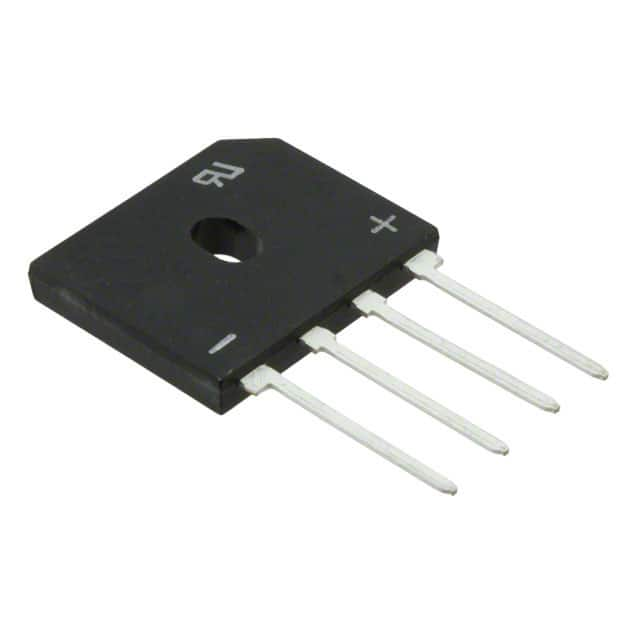Viz Specifikace pro podrobnosti o produktu.

GBU6K-E3/45
Introduction
The GBU6K-E3/45 is a rectifier diode belonging to the category of semiconductor devices. This entry provides an overview of its basic information, specifications, pin configuration, functional features, advantages and disadvantages, working principles, application field plans, and alternative models.
Basic Information Overview
- Category: Semiconductor device
- Use: Rectification of alternating current (AC) to direct current (DC)
- Characteristics: High current capability, low forward voltage drop
- Package: GBU package type
- Essence: Bridge rectifier diode
- Packaging/Quantity: Typically available in reels or tubes containing multiple units
Specifications
- Maximum Average Forward Current: 6A
- Peak Repetitive Reverse Voltage: 400V
- Forward Voltage Drop: Typically 1.1V at 6A
- Operating Temperature Range: -55°C to +150°C
- Storage Temperature Range: -55°C to +150°C
Detailed Pin Configuration
The GBU6K-E3/45 typically has four pins arranged in a bridge configuration. The pinout is as follows: 1. Pin 1: AC input terminal 1 2. Pin 2: AC input terminal 2 3. Pin 3: DC output terminal 1 4. Pin 4: DC output terminal 2
Functional Features
- Efficiently converts AC to DC
- Low forward voltage drop minimizes power loss
- High current capability allows for use in various applications
- Reliable and durable design
Advantages and Disadvantages
Advantages
- High current capability
- Low forward voltage drop
- Reliable performance
- Wide operating temperature range
Disadvantages
- Higher cost compared to standard diodes
- Larger physical size due to the bridge configuration
Working Principles
The GBU6K-E3/45 operates on the principle of rectification, where it converts the incoming AC voltage into a pulsating DC voltage. This is achieved through the bridge rectifier configuration, allowing for efficient conversion with minimal power loss.
Detailed Application Field Plans
The GBU6K-E3/45 is commonly used in various applications such as: - Power supplies - Motor drives - Battery chargers - Welding equipment - Industrial automation systems
Detailed and Complete Alternative Models
Some alternative models to the GBU6K-E3/45 include: - GBU6J-E3/45 - GBU6M-E3/45 - GBU6L-E3/45 - GBU6N-E3/45
These alternative models offer similar rectification capabilities with slight variations in specifications and characteristics.
In conclusion, the GBU6K-E3/45 is a reliable and efficient bridge rectifier diode suitable for a wide range of AC to DC conversion applications.
Word count: 411
Seznam 10 běžných otázek a odpovědí souvisejících s aplikací GBU6K-E3/45 v technických řešeních
Sure, here are 10 common questions and answers related to the application of GBU6K-E3/45 in technical solutions:
What is the GBU6K-E3/45?
- The GBU6K-E3/45 is a bridge rectifier diode that is commonly used in power supply and general rectification applications.
What is the maximum average forward current for GBU6K-E3/45?
- The maximum average forward current for GBU6K-E3/45 is 6A.
What is the maximum repetitive peak reverse voltage for GBU6K-E3/45?
- The maximum repetitive peak reverse voltage for GBU6K-E3/45 is 1000V.
What is the typical junction capacitance for GBU6K-E3/45?
- The typical junction capacitance for GBU6K-E3/45 is 150pF.
What are the typical applications for GBU6K-E3/45?
- GBU6K-E3/45 is commonly used in AC/DC power supplies, DC motor drives, and general rectification circuits.
What is the operating temperature range for GBU6K-E3/45?
- The operating temperature range for GBU6K-E3/45 is -55°C to +150°C.
What is the package type for GBU6K-E3/45?
- GBU6K-E3/45 comes in a standard D-63 package.
What are the key features of GBU6K-E3/45?
- Some key features of GBU6K-E3/45 include high surge current capability, low thermal resistance, and high isolation voltage.
Can GBU6K-E3/45 be used in high-frequency applications?
- GBU6K-E3/45 is not recommended for high-frequency applications due to its inherent limitations in switching speed.
Is GBU6K-E3/45 RoHS compliant?
- Yes, GBU6K-E3/45 is RoHS compliant, making it suitable for use in environmentally conscious designs.

